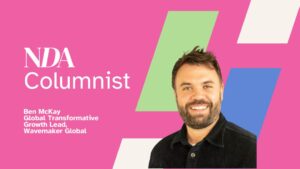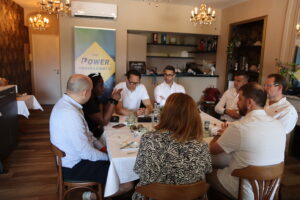Rob Webster is Founder of Canton Marketing Solutions. He’s worked in the adtech industry since 2001 and is NDA’s monthly adtech columnist.
2021 like 2020 before it will go down as two of those generational years where the world and digital marketing in particular changed. We are just getting started, where 2021 got marketers used to adapting to new working conditions 2022 is where marketers will have to adapt to whole new way of planning and buying media. Advertisers will need to rebuild their setups and publishers adapt or die to changing conditions.
Before looking at 2022, a quick word on 2021. You can read my predictions from last year here. Now I have to confess that I expected Google to keep to its original timeline and end the third-party cookie now now in 18 months time. Yet my central point that privacy would bite has still come true. Apple moving IDFA to opt in (effectively double opt in for tracking and targeting to work) means that for the richest billion people on earth mostly use devices that are privacy first. Publishers have seen this bite into their returns for these devices / people and advertisers have had their display and social strategies splintered by the change.
Combine that with the predicted talent crunch where the demand for practitioners, people who are adtech and buying platform literate far outstrips supply and you have the central themes of the year. GAFA has increased its hold on the market, notably with Apple now the dominant advertising platform for IOS downloads with this share largely coming from smaller independent providers. Though I got the Google prediction wrong everything else I got right. With that in mind, on to 2022.
Privacy takes another huge step forward
The arrow of time always points in one direction, we forever move forwards (in time). As it is for time, so it is for privacy. Most people understand this but most dont realise the pace of change we are in today and the pace we will have to get to a privacy-first world. Privacy regulation that started with GDPR and continued with CCPA now marks its inexorable movement market by market, US state by US state. For more particular changes, as I have learnt with Google, its difficult to know which change will happen exactly when. However we do know what changes will happen over the next few yeas, much of which will happen next year. Below is a brief list of changes that will happen, territory by territory by 2025. Some, but not all of it will happen in 2022 and the 2022 changes will drive privacy at an ever faster rate.
- Regulators will rule that the current way consent is granted by a TCF interstitial granting hundreds of companies consent in fact does no such thing and is not compliant.
- ‘The RTB practice of broadcasting IDs to hundreds of companies will similarly be ruled non compliant. The UK ICO hinted at this in a statement last month.
- Google\s Android app ecosystem follows IOS in not allowing unfettered use of the Android ID without consent.
- Regulators start taking companies to court at ever greater scale for privacy breaches. Enshrining privacy rules in law with precedent and clarifying what is and is not compliant. This moment will send ripples through the industry.
- The IP address, a key component of many of the cookie-free workarounds will become unusable for such purposes as it is hidden from advertisers. This will kill off many efforts at “fingerprinting” that many adtech companies rely on.
- Regulators take actions against the dominance of GAFA. Such action will take years to settle but will act as a catalyst for the large players to divest assets and prepare for potential breakups.
- Universal ID graphs are considered to not be sufficiently consented and are effectively non compliant. This is particularly likely to occur in Europe first likely in 2022.
If you want to understand the likely impact of these future changes watch what happened to app downloads when Apple made the IDFA opt in. As the changes above come into play they can dwarf this impact and when the privacy journey is complete a whole new way of marketing is required to what we have become used to the last 20 years.
My focus in 2022 will be to help advertisers and publishers prepare for these changes such that they can thrive. However also to attempt to influence regulators such that their changes help society as a whole and don’t concentrate too much power in the hands of the established giants. It really is a case where better regulation can build a better world.
Now on to some punchier recommendations.
Advertisers and marketers radically restructure their campaign setups
Hardly any campaigns are setup differently on Chrome vs Safari (or other browsers). Dittor in the app world, Android v IOS. Yet they should be as the way they are run and measured is chalk and cheese. Other changes involve more use of location, new ways of planning and buying contextual, more algorithmic options. More channel choices. In order to compete in the new world you need to buy differently and better.
The biggest year ever for MAD tech
Adtech and martech have been getting closer for years. The CDP space has now effectively merged with the DMP space signifying that adtech and martech are now largely operated by the same companies and with the same practitioners. Many advertisers have under invested in MAD tech during turbulent times causing a huge technology debt. 2022 is the year this debt will be (and needs to be to succeed) repaid. With the pandemic becoming the new normal and privacy already preventing advertisers from reaching the richest billion (Apple users) in traditional means marketing technology transformation is essential and in demand. An incredibly exciting time for those with new breed products to sell or the skills install and use them.
Education, education, education (training, training, training)
So many companies now are trying to hire the skills that they need. MAD tech-literate practitioners and experts. Companies can hire a specialist or two to lead this but the numbers to fill the roles needed simply arnt there. Given these skills are so essential the only solution is training. Marketers of a previous generation are fretting (and rightly so) that their skills do not have the demand of old, these people need to upgrade their skills. A wave of new blood too will come into the industry and that also needs training. Its a great time to join the industry or learn new skills. It’s an even better time to be a great teacher and have a strong training program.
Fragmentation and automation
Across the whole world there is a huge macro trend for automation. In some senses marketing is going the other way, privacy is creating fragmentation as can be seen by the huge number of CDP and clean room companies that exist and pop up. There is no one winner yet in many of the new privacy technologies and in many cases you need different vendors in different markets. In 2022 global advertisers will need to use more different tech companies than ever before.
Yet automation is too powerful a trend to be ignored completely. In more established disciplines automation is in full chat. In paid search for example there is a huge move towards so called “smart campaigns” that handle optimisation. Indeed it is no surprise that paid search, probably the most bullet-proof digital channel right now has the most automation efforts. The only thing more effective in marketing right now that a superstar search buyer is a superstar search buyer unleashed with the best automation technologies and techniques. This push for automation is also alive and kicking in creative, personalisation, recommendations and more. As the privacy revolution takes its course we will end up with a much safer and much more automated world. For that dream we may have to wait a few years yet 2022 will be one of the years where the dream moves closer to reality at pace.
Measurement and attribution
I will be talking a lot about this in early 2022 – its going to be one of the themes of the year. The fact is that most advertisers’ measurement capabilities have never been weaker. They are essentially blind to activity happening on Apple devices and so are largely blind to the richest billion people on the planet. This makes such current efforts almost laughably inadequate. Further, a great measurement capability has a true understanding of incrementality and life time customer value at its core – a capability that that drives growth.
On this criteria too almost every advertiser falls far short. Yet new ways of thinking and solutions exist, it will take time but the best and most ambitious advertisers will transform their capabilities here in 2022 and it is these advertisers who will be most successful in the years to come. Already we are seeing big investment in new solutions, automating data into cloud environments, turbocharging predictive technology (media mix modelling-based) and allowing for marketing testing and experiments to be done at scale. 2022 is the year where measurement regains its rightful place as the most important discipline in marketing and fixes the sins I outline at the start of this paragraph. Its also the place where I will be putting most focus next year.
2021 has had its challenges. I certainly wasn’t a fan of a locked-down winter yet its also a year that has created huge opportunities for those that are willing to learn and adapt. This will be even more true in 2022 and its a world I am excited to be operating in and hopefully in some way influencing. See you all in the new world.
Merry Christmas all.










